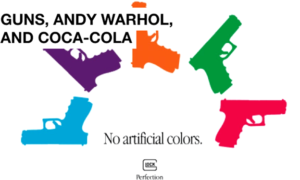By Ben Langlotz
|
December 4, 2021
|
Firearms
|
0 Comments
THE SWEET SPOT FOR SUCCESS IN OUR INDUSTRY?

Selling Pistols like Soda Pop – Andy Warhol-style?
It’s rare to find something on the Internet that gives you a new perspective on one of the most important aspects of your own life. We usually are seeing things that either enrage us, or reinforce what we already believe.
Thankfully, I got permission from the author of this Substack publication to share it with you in its entirety, (along with my commentary). Open Source Defense bills themselves as “100% gun rights, 0% culture war. Making people proud to be associated with gun rights, with friendly, thoughtful, and incisive writing on guns.” Here’s what they wrote:
Good products are good. The best products are good and affordable.
This is a good time of the year to get a deal on gun stuff. Which gun stuff to buy is a harder question.
As guns continue to attract a wider audience, the products are getting better. That makes intuitive sense; a bigger, more engaged audience increases the returns on innovation, which in turn attracts innovators. But products “getting better” isn’t just a vague trend. It has a specific meaning. What “better” really means is “higher value per dollar”.
(Ben adds: I’ve often advised people who ask what gun to buy: “Guns are like cars these days. They’re all good. If you’ve heard of the brand, it’s going to be good. Buy the one you think is cool that you can afford.”)
Andy Warhol said this about a particularly high-value-per-dollar good in 1975:
“You can be watching TV and see Coca-Cola, and you know that the President drinks Coke, Liz Taylor drinks Coke, and just think, you can drink Coke, too. A Coke is a Coke and no amount of money can get you a better Coke than the one the bum on the corner is drinking. All the Cokes are the same and all the Cokes are good. Liz Taylor knows it, the President knows it, the bum knows it, and you know it.”
(Ben: The same for our world. You can carry the same pistol and chamber and the same ammo as the Secret Service, or the Navy Seals. But your comms and transportation might be lacking a bit – more on that later. Except that you’re using the exact same gasoline they use.)
That makes a useful rule-of-thumb for how innovative a consumer industry is: do billionaires and middle-class people buy the same product? There’s nothing necessarily wrong with an industry that doesn’t pass that test — it just means there’s still a lot of value left to be created.

1993 vs. 2013
For example, consider a reddit post from nine years ago, titled “1993 vs. 2013”:
For each device that the iPhone replaced, in 1993 a billionaire would own a much better version than what a middle-class person would own. The latter might not have owned, say, a camcorder or a cell phone at all. Today, everybody buys the same handful of smartphones, because they’re the best option at any price.
(Ben adds: I’m a photography enthusiast, and spend my allowance on new camera lenses that cost thousands of dollars, and that I know I can resell at little loss in the year ahead if I shift interests. I don’t kid myself that these take pictures of my kids that anyone can tell are different than the phone pictures Karmen takes. Our Christmas card has a mix of mine, hers, and the professional photographer’s, whose gear isn’t quite as good as mine. You can’t tell the difference. My point is that NOBODY (except nerds like me and a few pros) buys cameras and lenses anymore.)
In reality, the 1993 vs. 2013 comparison is even starker than what’s in the picture. Because it’s not just that the iPhone substitutes all those devices, it’s that it completely supplants them (Ben: It outperforms each one in every respect). In 1993, you couldn’t have bought iPhone-like functionality at any price.
So how does this apply to guns?
Well, you can break the industry into three categories: products that have completed this Warhol shift, those that are mid-shift, and those that are still pre-shift.
“Post-shift”
Examples
- Striker-fired polymer handguns (Glocks and similar designs)
- Rimfire firearms, for the most part (excluding niche competition target guns)
- FMJ ammo
- Most software products and internet platforms
What’s next for products in this category
These are products where money doesn’t buy you better outcomes today, but that doesn’t mean the products are perfect. The path forward on these is to just keep making them better. Plenty still left to do here, especially in the internet space.
(Ben adds: Some of the big areas to focus on improving seem to involve designs that can be user-fabricated with 3D printing, such as serialized frame modules with the rest being unregulated or user-printed. Also, making the products appeal to new entrants to firearms, such as “moms” who worry most about safety, and might be attracted to more layers of safety that make intuitive sense.)
“Mid-shift”
Examples
- ARs and other common centerfire rifles
- Scopes and red dot optics
- Chest rigs
- Belts
- Holsters
- Suppressors
(Ben adds: I think the author might have added silencers to the list after I suggested it, especially in the context of a hypothetical deregulation of silencers. Other categories I’d add: Guns that comply with abusive local regulations (CA, NY) to give those markets access to cool guns. Bump stocks and pistol braces are examples of this that avoid treading on certain federal laws. Other categories include unusually compact guns for carry or curiosity, odd new configuration that satisfy the need of a segment that favors the new form or likes to collect innovations. One example that touches on most of these is the new PIVOT™ 9mm rifle from Trailblazer that achieves the smallest theoretical stowed length when folded that still complies with barrel length regulation. It hits all of those notes.)
What’s next for products in this category
On these, there’s an active trend moving in the right direction. Spending 2-3x more still buys you a better AR or a better scope than the budget option — but the gap is smaller than it used to be, and it’s shrinking. Look for high-dollar incumbents here to face growing competition from the budget end of the market.
(Ben adds: What blew me away about this article was the realization that what the author calls “Mid-Shift” is the sweet spot of my practice that serves the industry’s innovation drivers. I’m not saying that Ruger and S&W (non-clients) don’t innovate, but the profits they generate come relatively less from technical innovation, and more from reputation. You could say that the ratio of their patent portfolio value to their trademark portfolio value is low, because those billion-dollar brands boost the denominator. But contrast Trailblazer, or Franklin Armory (Binary triggers and much more), or the guy you never heard of that is getting royalties on a new locking system for a rifle.)
“Pre-shift”
Examples
- Night vision goggles
- IR devices like the MAWL and PEQ-15
- Body armor
- Radios and comms
(Ben adds: This is an interesting category. The general reaction to many of these from outside of our industry would be “No one should have/need those!” Which is just what we would have heard a generation ago for AR-15 rifles, and widespread concealed carry. The business success may be in the “mid-shift” category, but the seeds for those categories are often in the “Pre-shift” category that makes many (including some of us) squirm a little.
I predict that we’ll see widespread night vision in smart phones before anyone in the industry takes it mass market. Some would argue it already is, but recall that having the poor-man’s version means that it isn’t post shift.
Leupold cleverly showed that IR can be sold as a hunter’s tool, and I love my thermal unit for diagnosing problems around the house. I have my own improvement/accessory/interface invention that overcomes the limited angular field of view, but won’t mention it until it’s patent pending. And the technology still needs to develop to be fully mature so mainstream is top-drawer.
“Body Armor” should be a very mainstream product. Sell it to nervous protective moms. The woke sportswear companies like Patagonia and Columbia won’t touch it, but someone smart like 5.11 or Under Armor will make a killing. Maybe a no-name maker for OEM branding by Cabela’s? Or for gun companies? That new pistol comes with a gift certificate for a vest rated to handle what the gun fires?
For comms, I’m not sure. That 1993 “before” picture is where we are today: Zoom conferencing on your phone. Google Glass with awkward eyeglasses. GPS navigation and “find friends” on the phone. Oculus virtual reality. Now, combine all those into one wearable device no one even notices, and that gives more uses than we can even imagine today, and you have the future.
What’s next for products in this category
These domains are still dominated by high-dollar incumbents. Historically, that plays out in one of four ways:
- It stays that way long-term
- The incumbents successfully move down-market
- They get disrupted from below by startups
(Ben: This is what you’re looking for. Find the seeds that will bear fruit.) - The entire domain fades away
The corollary is that as long as the domain itself doesn’t disappear, these domains with fat-and-happy incumbents are the ones with the richest rewards for a startup that manages to break in and change things.
What are your favorite companies attacking mid-shift and pre-shift domains? Reply and let us know. Especially if you’re the one starting the company.
(Ben adds: if your disruptive effort is already underway, and you’re ready to protect your innovations, give me a call and we can discuss strategy and timing.)
See you at SHOT!
Flights and rooms are booked. Show credentials are paid for. Fakemaskworldwide.com masks ready for air travel and persnickety door guards. Vitamin D levels verified healthy (my doc says that no one with good D3 levels gets a serious case of Covid, and I believe him – wish it worked on colds brought home by preschoolers!). Still mourning loss of the Caliber Club, but looking forward to seeing y’all. Be sure to email to remind me to stop by your booth or meet you in the aisles.
As far as mask enforcement, NSSF’s Chris Dolnack posts on social media that: “The Venetian has told us that they will enforce it vigorously as the NV Gaming Commission over sees the casino properties and will likely be on site. I expect to see a lot more security on the floor. But throughout the entire facility as I understand it.” It will be interesting to see how the system responds to an industry in which the vast majority disapprove of mask mandates, and won’t wear a mask unless required.